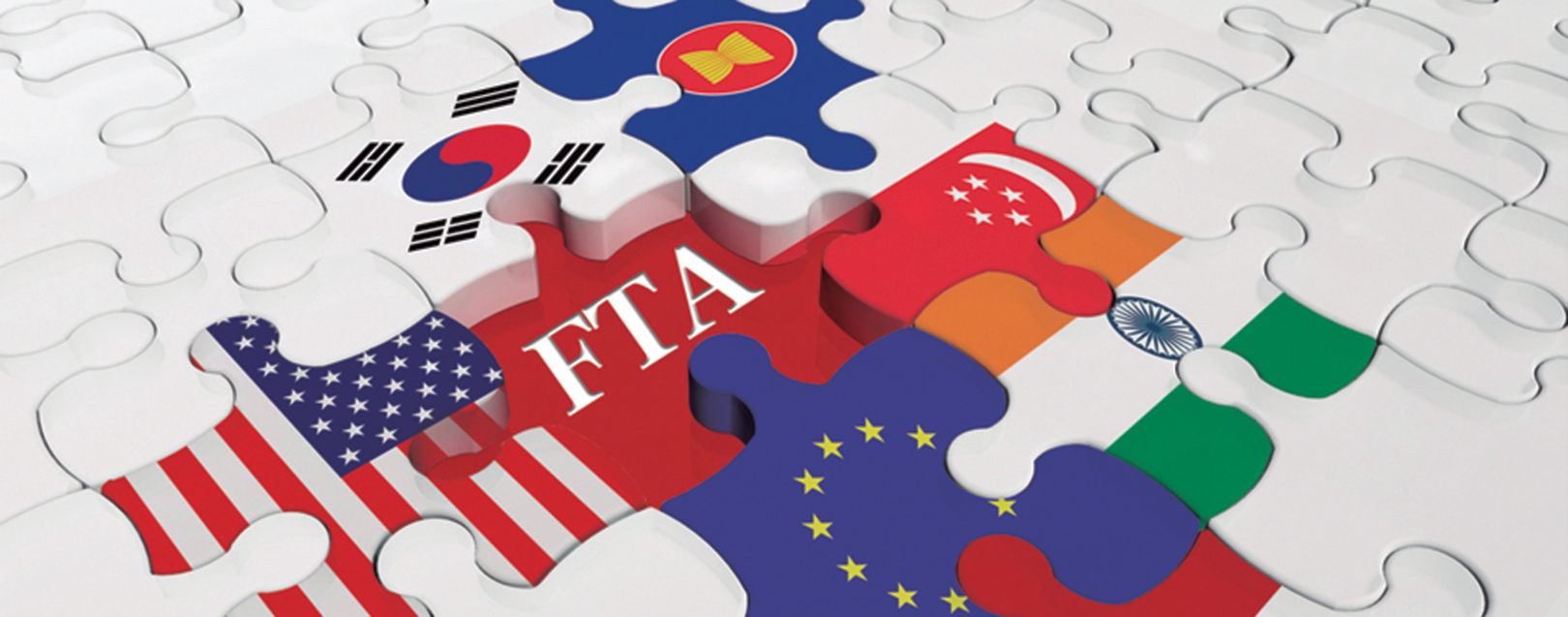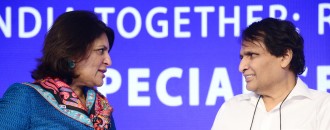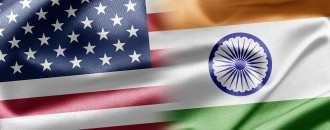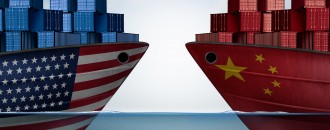
Free Trade Agreements: Fears sans cheers!
Steven Philip Warner | The Dollar Business It’s easy to welcome diplomats for dinner sponsored by your taxpayers. It’s another thing to convince them to open their doors to your exporters. Eat they will [do you hate free lunches?] but apple polishers vanish when you have a price tag pegged to your homemade dishes. India’s experience is such. The reference to foreign representatives and “making them give too”, is because 2015 is a special year. Big, actually. Two mega-foreign trade pacts (FTAs/RTAs) should come into force this year involving nations accounting for over 60% of world GDP. One being the Transatlantic Trade and Investment Partnership (TTIP) between EU and US, the other being the Transpacific Partnership (TPP) that US will lead (no surprise there!) in signature style alongside 11 other nations. And India, despite all the chemistry and camaraderie in display of late with foreign lords, has not been invited to join either of these blocs! Some woodenheads lament this – and go about proclaiming how hopeful they are about the red carpet being rolled out for India. They claim this is critical to growing India’s foreign trade relations, especially given that the China-led Regional Comprehensive Economic Partnership (RCEP) is making love-laden progress (the last meeting of this proposed block was concluded at Pattaya, a day before Valentine’s Day). That FTAs (and RTAs) make exports like shooting fish in a barrel is a case of shallow thought having grown popular. There are several reasons why India should not be forced by a handful of armchair economists to join this new world order that comes in the name of FTAs. First, FTAs these days actually have the ‘A’ for “Agreement” scissored; these are called “Partnerships” (think of RCE‘P’, TP‘P’, TTI‘P’, etc.). There is little point in ego massaging oneself by being able to call any First World nation an on-paper “partner”. Organically derived equality will take time. It should take time. And till that occurs, a nation’s complex should not be got over by a few scribbles in the name of FTAs. Second, look back at how poorly India has performed on FTAs. The RCEP was a strict no because India has accumulated a total trade deficit of over $300 billion with the proposed member nations in aggregate (and more than 54% of that amount with China!). With TPP, even if Obama comes inviting with a precious scroll and rewrites history by becoming the first US President to land on Indian soil a third time (and this time on Independence Day?), India should stick to saying no to TPP. Same logic. India runs a trade deficit with 67% of members proposed to join the TPP and has accumulated deficit of over $30 billion in the past five years with the bloc. FTAs aren’t serving India well. Let’s accept that in all honesty. No point blaming observers for calling FTA “the devil”. FTA is an unnecessary evil. It’s confession time. In the past five years, India’s deficit with its FTA members (ex SAARC) has totalled over $135 billion. The only bloc with which it runs a positive trade is SAFTA – obviously because they are obliged to import from India (nations like Afghanistan, Nepal, Pakistan, Bhutan, etc.). It’s shocking how even with Latin American nations like Chile, Argentina, Uruguay and Paraguay, we are sitting on a negative trade inequation. Let’s turn our focus to these nations, than waste time on FTA negotiations. Third, you may think that it’s easy to recommend walking away from FTAs – but why are we recommending that our exporters get over the habit of FTA-driven zero import tariff advantages? The answer is – we have a body called DGFT which pens down a document called FTP. Incentivise exports (expand what falls under the ambit of every export-related scheme – what does the government lose if exporters get motivated to manufacture and export?!) to an extent that Indian exporters will not require tariff mercy from foreign nations. Yes, WTO may object – but till the time the future of its very own Doha Development Round is uncertain, India will have to work hard and talk tough to defend its flag bearing exporters. [FTAs have done enough damage already.] Fourth, talking further on incentives – the revenue forgone by our Customs department was Rs.2,60,714 crore in FY2014. Of this, 23% was on account of various export promotion concessions, the rest due to FTAs! FTAs are not only increasing our trade deficit but also causing direct loss to our coffers. Is that good? We’d rather have rupees 2 lakh crore being doled out to exporters as a stimulant. Won’t we? Fifth, talking of even imports, FTAs thus far have not worked for the benefit of the ordinary Indian wholesale or retail buyer. I ask this for lack of historical proof – has the government ever signed an FTA with a nation with a “written promise” that the price benefit that comes from the lowering of duty over time imposed on an imported product will be passed on to the final Indian buyer? Sixth, all that FTAs are doing at this time is discouraging domestic manufacturing by making India’s large consumer market a haven for foreign products. Mind you: we are not activists who opine that shutting our borders to global brands is the right path; but why should we in the name of zero duties (allowed under FTAs) permit finished products to be dumped into our country and destroy our own manufacturing sector? Seven, the oft-referred to sphagetti bowl. Take India-Sri Lanka for example. The two nations have signed three FTAs till date. One being bilateral (which is heavily skewed in favour of Sri Lanka; do read the agreement – one part of it talks about concessions on import duties on sourcing of fabrics from India and the resultant finished apparel articles from Sri Lanka to India!), and two being multilateral under the SAPTA and SAFTA. There are duplications in terms of product categories covered under the three FTAs that will leave you wondering if a college graduate worth his salt ever got a chance to approve the fine print. Eight, India should not sign an FTA and find itself not conforming to ground rules. For instance, the TPP has sophisticated elements of modern-day trade included – like an agreement on labour standards, environmental standards, and IPR. These are elements that suit the First World. I can never imagine India imposing a rule on a strict eight-hour office cycle (EU’s Working Time Directive requires EU nations to guarantee a limit to weekly working hours not exceeding 48 hours on average, including all overtime; and the German labour ministry has banned “all out of hours working” – means no phone calls-no emails except when in office). It’s time for India to work more than just 48 hours a week, considering the stage of economic development we are in. Ninth, India’s National Manufacturing Policy promises to create 100 million jobs and contribute 25% to GDP in a decade. And there is the Make in India campaign to serve. The larger vision is therefore to make India a net exporter. Call it limitations on existing capabilities of India’s manufacturing infrastructure or lack of bargaining power on the part of our plenipotentiaries, FTAs don’t seem to be the answer that works. Tenth – if China and US are signing FTAs, why shouldn’t we try and match up to the dragon? The best answer to this would be: pay a visit to Beijing or Guangzhou and understand how China is handling a population bigger than India’s with great ease and then ask whether we have progressed enough to talk on a level-playing field. The second best would be a reference to the research conducted by Badri Narayanan (Purdue University) and Sachin Sharma (Centre for WTO Studies). The researchers have concluded in a May 2014 paper (An Analysis of Tariff Reductions in TPP: Implications for The Indian Economy) that, “India loses in terms of GDP, in all scenarios when it reduces tariffs. Higher welfare arising from allocative efficiency, come with the cost of relatively lower consumption of domestic products and investment, resulting in the loss in terms of GDP.” As for others, it summarises, “When China reduces its tariffs, it enjoys increase in both GDP and welfare. Japan and USA emerge as the biggest winners in terms of both GDP and welfare...” Enough reasons therefore for others to indulge in FTAs – a ground where India should avoid treading on for now. India has to stop being politically timid for once, and not avoid hard truths that make business sense. Hope-driven incalculable extrapolations should give way to direct action and incentives for exporters in the forthcoming FTP. Let’s believe in our own worth, and stop take pride in signing a piece of paper that makes India rich in FTA numbers.






 to success.
to success.